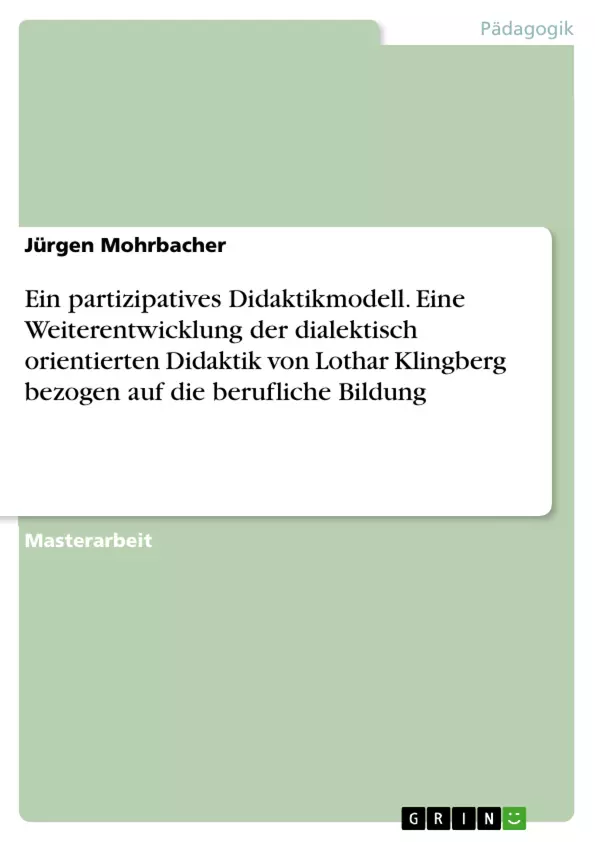Die Teilnehmer in der beruflichen Bildung bringen Wissen aus ihrer Praxis mit in den Unterricht. In einer Literaturrecherche wurde untersucht, in wieweit Aussagen von Autoren zutreffen, dass von Teilnehmerinnen und Teilnehmern am Unterricht beigesteuerte neue Inhalte dazu beitragen. das Wissen der Lehrenden zu erweitern. Die Lehrerinnen und Lehrer lernen auch von den Teilnehmern. Diese Aussagen wurde in einer Stichprobe (N=167) von den Berufsschullehrerinnen und Lehrern an baden-württembergischen Berufsschulen untersucht. Das Ergebnis der Untersuchung zeigt auf, dass Lehrerinnen und Lehrer anerkennen, dass Sie von Schülerinnen und Schülern lernen können. Beim Entscheidungsprozess der Methodenwahl durch die Lehrenden, werden die Teilnehmerinnen und Teilnehmer nur im geringen Umfang mit einbezogen.
Der Unterrichtsprozess in der beruflichen Bildung sollte einen partizipativen Charakter aufweisen. Hierzu wird ein partizipatives Didaktikmodell auf der Grundlage der dialektischen Didaktik von Lothar Klingberg und des humanistischen Modells der „Themenzentrierten Interaktion“ von Ruth C. Cohn vorgestellt. Die Stärkung des Subjekts innerhalb der Gesellschaft, besonders im Beruf, steht im Vordergrund dieses Didaktikmodells.
Participants of vocational training often bring along their practical know-how and knowledge into the lesson. A literature research analyzed how far the statements of authors are true, that new contents given by the participants’ input can contribute to the extensions of their teachers’ knowledge. Teachers also benefit from their students. A random check (N=167) of active vocational school teachers in Baden-Württemberg demonstrates shows whether these statements are true or not. The result of this research shows that teachers are actually aware that they profit from their students’ knowledge. Nevertheless, students are less involved in the decision-making process with regard to the choice of methods.
However, the process of teaching in vocational education should have a clear participative character. For this purpose a didactic participative model is introduced. Basics of this mod-el are the “dialectic didactics” by Lothar Klingberg and the humanistic model of the “theme-centered interaction” of Ruth C. Cohn. The most important issue of this didactic participatory model that the human subject within the society should be strengthened espe-cially regarding his profession.
Inhaltsverzeichnis
- Zusammenfassung
- Abstract
Zielsetzung und Themenschwerpunkte
Diese Masterarbeit befasst sich mit der Entwicklung eines partizipativen Didaktikmodells für die berufliche Bildung. Das Modell basiert auf der dialektisch orientierten Didaktik von Lothar Klingberg und dem humanistischen Modell der „Themenzentrierten Interaktion“ von Ruth C. Cohn. Die Arbeit untersucht die Rolle der Teilnehmer in der beruflichen Bildung und ihre Beiträge zum Wissen der Lehrenden.
- Partizipation in der beruflichen Bildung
- Dialektische Didaktik und Themenzentrierte Interaktion
- Subjektorientierung und Stärkung des Subjekts
- Entwicklung eines partizipativen Didaktikmodells
- Beitrag von Teilnehmern zum Wissen der Lehrenden
Zusammenfassung der Kapitel
Die Arbeit beginnt mit einer Literaturrecherche, die die Bedeutung von Teilnehmerbeteiligung in der beruflichen Bildung und den Einfluss von Teilnehmerwissen auf das Wissen der Lehrenden untersucht. Anschließend wird ein partizipatives Didaktikmodell vorgestellt, das auf der dialektischen Didaktik und der Themenzentrierten Interaktion basiert. Das Modell zielt darauf ab, die Subjektorientierung in der beruflichen Bildung zu fördern und die aktive Beteiligung der Teilnehmer am Lernprozess zu stärken.
Schlüsselwörter
Die Arbeit konzentriert sich auf die Schlüsselwörter Dialektik, Didaktik, Partizipation, Subjektorientierung, Subjektorientierte Erwachsenenbildung und Themenzentrierte Interaktion. Diese Begriffe bilden die Grundlage für die Entwicklung des partizipativen Didaktikmodells und die Analyse der Rolle der Teilnehmer in der beruflichen Bildung.
- Quote paper
- Jürgen Mohrbacher (Author), 2015, Ein partizipatives Didaktikmodell. Eine Weiterentwicklung der dialektisch orientierten Didaktik von Lothar Klingberg bezogen auf die berufliche Bildung, Munich, GRIN Verlag, https://www.grin.com/document/375261




